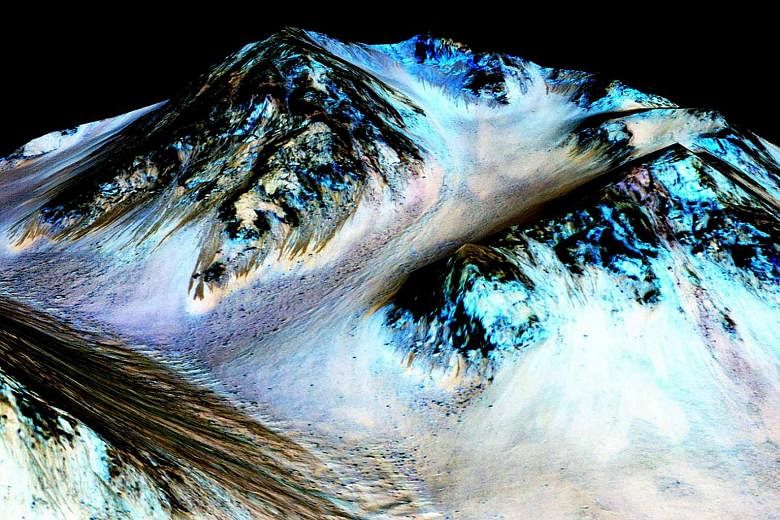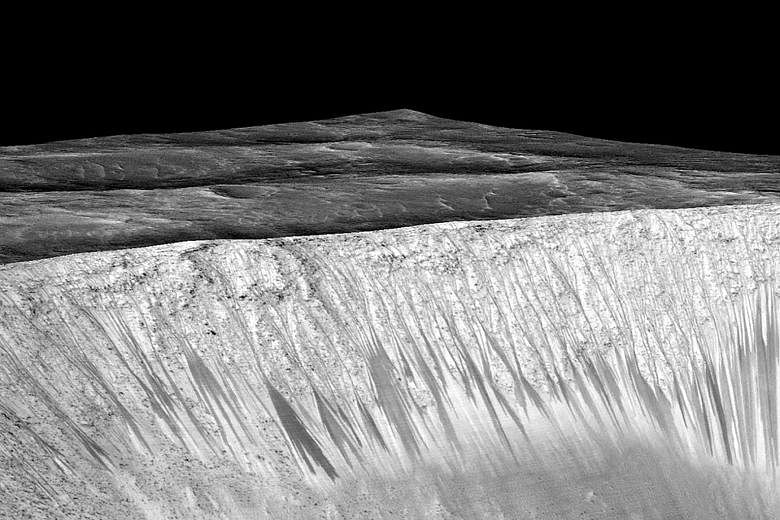WASHINGTON (AFP) - Liquid water has been observed on the planet Mars, the US space agency Nasa said Monday.
"Mars is not the dry, arid planet we thought of in the past," Mr Jim Green, Nasa's planetary science director, told a press conference. "Under certain circumstances, liquid water has been found on Mars."
Scientists have long believed that water once flowed freely across the Red Planet and was responsible for forming its valleys and canyons.
Major climate change about three billion years ago is believed to have changed all that, Mr Green said.
"Today we're revolutionizing our understanding of this planet," Mr Green said. "Our rovers are finding there's a lot more humidity in the air."
The rovers searching the planet's surface have also found that the soil is much more moist than anticipated.
Dark streaks running down slopes on the Martian surface were observed about four years ago.
Scientists did not have proof, however, that these streaks - which would form in spring, grow by summer and then disappear by fall - were actually water.
But after careful study and analysis, they are ready to say that these streaks are, in fact, water.
The curious lines running down slopes on the Martian surface may be streaks of super-salty brine, said the latest finding in the scientific quest for extra-terrestrial liquid water, a prerequisite for life.
A team from the United States and France said it found evidence in the lines of "hydrated" salt minerals, which require water for their creation.
These results "strongly support the hypothesis" of liquid water on Mars today, concluded a research paper published in the journal Nature Geoscience.
Astrophysicists have long hypothesised that the seasonal streaks, dubbed "recurring slope lineae" (RSL), may be formed by brine flows on the Red Planet.
The lines, up to a few hundred metres in length and typically under five metres wide, appear on slopes during warm seasons, lengthen, then fade as they cool.
But spacecraft images have not been detailed enough to probe what is within the lines - the pixel resolution is coarser than the width of the streaks.
In April, scientists reported in the same journal that perchlorate salts, like the ones in the new study, were "widespread" on the surface of our planetary neighbour and humidity and temperature conditions just right for salty brines to exist.
Perchlorate is highly absorbent and lowers the freezing point of water so that it remains liquid at colder temperatures.
The new study found signs of these same salts in the enigmatic streaks.
"What our paper does is further substantiate that theoretical possibility" of liquid brines on Mars, co-author Lujendra Ojha of the Georgia Institute of Technology in Atlanta told AFP by email.
The team devised a method to extract more data from individual pixels in images from the CRISM spectrometer instrument on Nasa's Mars Reconnaissance Orbiter, and found details "consistent with the presence of hydrated salt minerals that precipitate (crystallise) from water," according to a Nature press release.
"The findings strongly suggest a link between the transient streaks on Martian slopes and the flow of liquid brines," it added.
Asked if the data was unequivocal proof of liquid water on Mars, another of the study authors, Alfred McEwen from the University of Arizona, told AFP: "I would say almost".
But if there was, it was likely "wet soil, not free water sitting on the surface," he said by email.
It is widely accepted that the Red Planet once hosted plentiful water in liquid form, and still has water today, albeit frozen in ice underground.
Earlier this year, Nasa said almost half of Mars' northern hemisphere had once been an ocean, reaching depths greater than 1.6km.
But 87 per cent of the precious substance was lost to space.





